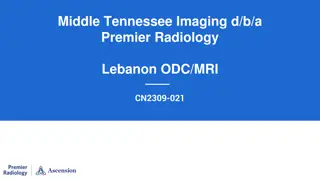Radiology of Hematopoietic Disorders by Dr. Sajjad Hussain - Imaging Insights
Detailed radiology images and descriptions of hematopoietic disorders including anemia, thalassemia, and more by Dr. Sajjad Hussain, Assistant Professor & Consultant in Radiology at King Saud University, King Khalid University Hospital.
Download Presentation

Please find below an Image/Link to download the presentation.
The content on the website is provided AS IS for your information and personal use only. It may not be sold, licensed, or shared on other websites without obtaining consent from the author.If you encounter any issues during the download, it is possible that the publisher has removed the file from their server.
You are allowed to download the files provided on this website for personal or commercial use, subject to the condition that they are used lawfully. All files are the property of their respective owners.
The content on the website is provided AS IS for your information and personal use only. It may not be sold, licensed, or shared on other websites without obtaining consent from the author.
E N D
Presentation Transcript
RADIOLOGY of HEMATOPOIETIC DISORDERS DR. SAJJAD HUSSAIN ASSISTANT PROFESSOR & CONSULTANT Department of Radiology and Medical Imaging KING SAUD UNIVERSITY KING KHALID UNIVERSITY HOSPITAL
BLOOD CELLS RBCs WBCs Platelets PLASMA
BLOOD CELLS Anemia Polycythemia Sickle cell Thalassemia Others nutritional, hemolysis etc. RBCs WBCs Platelets PLASMA
BLOOD CELLS Anemia Polycythemia Sickle cell Thalassemia Others nutritional, hemolysis etc. RBCs WBCs Lymphoma Leukemia Multiple myeloma Platelets PLASMA
BLOOD CELLS Anemia Polycythemia Sickle cell Thalassemia Others nutritional, hemolysis etc. RBCs WBCs Lymphoma Leukemia Multiple myeloma Platelets PLASMA Bleeding / clotting disorders
A N E M I A Reactive increase in red bone marrow Expanded bone marrow in bones including long bones of hands, feet, limbs, skull Decreased T1 MRI signal in vertebral body bone marrow than adjacent discs Liver, Spleen, Lymph nodes, Thymus, Paraspinal areas with possible extension into spinal canal outside the dura, Kidneys, Meninges, Skin New marrow areas in potential organs Transfusions Iron overload Increased CT density (brightness) and changes in MRI signal of liver & spleen SCA Pneumonias, Osteomyelitis Infections Spleen, Kidneys, Brain, Bones Infarcts
Thalassemia Decreased bone density with coarse trabeculae Wide medullary cavity with thin cortex Normal for comparison
Severe chronic anemia Normal for comparison
25-year-old man with -thalassemia. Lateral skull radiograph shows expansion of diploic space with hair-on-end appearance widened groove for middle meningeal artery Spared occipital bone (arrow) File:Skull X-ray - lateral view.jpg Normal for comparison Georgiades C S et al. AJR 2002;179:1239-1243
File:Skull X-ray - lateral view.jpg Normal for comparison Severe chronic anemia
Axial CT image of upper skull (left) shows diploic space widening and trabecular prominence Sagittal MRI of brain (right) shows diploic space widening representing red marrow (*). Note spared occipital bone (arrows), which has no marrow elements Lonergan G J et al. Radiographics 2001;21:971-994
25-year-old man with -thalassemia. PA radiograph of chest (left) shows diffuse expansion of ribs and right upper paraspinal thoracic mass (arrow) compatible with extramedullary hemopoiesis. -thalassemia Normal for comparison Georgiades C S et al. AJR 2002;179:1239-1243
51-year-old woman with myelofibrosis. Coronal T1-weighted MR image shows massively enlarged spleen Splenic biopsy was followed by splenectomy Pathologic examination revealed extramedullary hematopoiesis Georgiades C S et al. AJR 2002;179:1239-1243
23-year-old woman with history of thalassemia and known extramedullary hemopoiesis PA chest film shows well-marginated bilateral, paraspinal masses compatible with extramedullary hemopoietic tissue Georgiades C S et al. AJR 2002;179:1239-1243
23-year-old woman with history of thalassemia and known extramedullary hemopoiesis. Axial contrast-enhanced CT scan through chest shows uniformly enhancing paraspinal hemopoietic masses with no bony erosion. Georgiades C S et al. AJR 2002;179:1239-1243
40-year-old man with sickle cell disease Axial unenhanced CT scan at thoracoabdominal level reveals two uniformly low-attenuation (compared with liver parenchyma), well circumscribed lesions (arrows) Percutaneous biopsy showed extramedullary hemopoiesis Georgiades C S et al. AJR 2002;179:1239-1243
56-year-old man with myelofibrosis Axial contrast-enhanced CT scan through kidneys reveals bilaterally symmetric enhancing perinephric masses. Biopsy showed extramedullary hematopoiesis Georgiades C S et al. AJR 2002;179:1239-1243
48-year-old man with hemolytic anemia and myelofibrosis Axial CT scan through pelvis shows well-marginated presacral soft-tissue mass (arrow) with no bony erosion Biopsy (not often needed) showed extramedullary hematopoiesis Georgiades C S et al. AJR 2002;179:1239-1243
Sickle cell disease may be manifested as ANEMIA ANEMIA Growth failure Hyperkinetic heart failure Expanded intramedullary hematopoiesis Presence of extramedullary hematopoiesis VASO VASO- -OCCLUSION OCCLUSION Infarcts in spleen, bone marrow, kidney, bowel, brain, muscles etc. SUPERIMPOSED INFECTION SUPERIMPOSED INFECTION Pneumonia (Pneumococcus, H. influenzae, Staph. aureus, Chlamydia, and Salmonella) Osteomyelitis (Salmonella) Lonergan G J et al. Radiographics 2001;21:971-994
Red marrow in vertebral bodies in a 7- year-old girl with Sickle Cell Anemia. Sagittal T1-weighted MRI of spine shows Low signal intensity in vertebral bodies compared to discs H-shaped vertebrae (arrows in right image) due to osteonecrosis of vertebral endplates Normal for comparison Lonergan G J et al. Radiographics 2001;21:971-994
Bone infarcts typically occur in the medullary cavities and epiphyses Epiphyseal infarcts are frequently seen in the femoral and humeral heads, and more often bilateral than avascular necrosis due to other diseases Lonergan G J et al. Radiographics 2001;21:971-994
Medullary bone infarcts in SCA Frontal radiograph of right shoulder in a 22-year-old patient shows an area of patchy sclerosis and radiolucency Normal for comparison Sickle cell anemia Lonergan G J et al. Radiographics 2001;21:971-994
AP radiograph in a 44-year-old man shows advanced avascular necrosis in left hip and a normal right hip Normal for comparison Sickle cell anemia Ejindu V C et al. Radiographics 2007;27:1005-1021
Sickle cell anemia Normal for comparison
Coronal STIR MR image in the same patient shows stage 1 avascular necrosis in right hip (arrow) as well, in addition to advanced changes of avascular necrosis of left femoral head Ejindu V C et al. Radiographics 2007;27:1005-1021
H-shaped vertebrae in a 15-year-old patient with SCA Lateral radiograph of spine shows classic boxlike endplate depressions in middle portion (see the lowest vertebra shown) due to osteonecrosis of the vertebral endplates Normal for comparison Lonergan G J et al. Radiographics 2001;21:971-994
Red marrow vertebral bodies in a 7- year-old girl with SCA. Sagittal T1-weighted MRI of spine shows low signal intensity in vertebral bodies compared to discs, and H- shaped vertebrae (arrows in right image) due to osteonecrosis of vertebral endplates Normal for comparison Lonergan G J et al. Radiographics 2001;21:971-994
Hand-foot syndrome (dactylitis) in SCA Frontal radiograph of right foot in a 3-year-old girl shows thick periostitis and subperiosteal new bone along the metatarsal shafts Lonergan G J et al. Radiographics 2001;21:971-994
Salmonella osteomyelitis in a 10-year-old boy with SCA Initial film (left) at onset of lower shin pain and fever is normal Film 7 days later (right) shows mottled lower tibial shaft and diffuse periostitis of the lower diaphysis Lonergan G J et al. Radiographics 2001;21:971-994
Bone infarcts and osteomyelitis are difficult to differentiate on history, clinical examination and plain x-ray images but are very important to avoid complications of osteomyelitis MRI findings of Cortical defects in bone Adjacent fluid collections in soft tissue Bone marrow enhancement are highly suggestive of infection Ultrasound guided aspiration of fluid collection around the involved bone can be confirmatory Lonergan G J et al. Radiographics 2001;21:971-994
Osteomyelitis of femur in a 24-year-old patient with SCA Axial T1-weighted MRI after contrast shows heterogeneous enhancement of marrow cavity, a rounded low-signal-intensity area adjacent to the shaft that is non-enhancing (fluid collection), and enhancement of the soft tissues around the shaft and of the adjacent musculature. Areas of enhancement are likely infected Lonergan G J et al. Radiographics 2001;21:971-994
Achilles tendon Soft-tissue infection in a 52-year-old man with homozygous sickle cell disease. Longitudinal high-resolution ultrasound image of left ankle shows a hypoechoic (dark) fluid collection (arrow) deep to Achilles tendon. Thick pus was aspirated from this area under ultrasound guidance Ejindu V C et al. Radiographics 2007;27:1005-1021
Chronic infarct in a 19- year-old patient with SCA and longstanding mild left sided weakness Axial T2-weighted MRI shows an area of high signal intensity and enlargement of overlying CSF spaces, compatible with chronic infarction and atrophy Lonergan G J et al. Radiographics 2001;21:971-994
Sequestration syndrome with splenic infarction in SCA Axial CT after contrast shows enlarged spleen that enhances heterogeneously and minimally with large non-enhancing areas (arrows) Photograph of spleen in a different patient shows areas of congestion and central necrosis Lonergan G J et al. Radiographics 2001;21:971-994
Papillary necrosis in SCA Frontal view of kidney during excretory urography in a 32-year- old man with SCA shows a small, round collection of contrast material in a missing papillary tip (arrow) Photograph of a kidney from a different patient shows loss of papillary tips in some upper pole pyramids (arrows). Lonergan G J et al. Radiographics 2001;21:971-994
Growth disturbance in distal radius in a 12-year- old girl Anteroposterior (AP) radiograph of left wrist shows epiphyseal shortening and a cup deformity of adjacent metaphysis. Also changes of old bone infarct in distal radius. Ejindu V C et al. Radiographics 2007;27:1005-1021
Hodgkins Disease Lymphocytic predominance Mixed cellularity Lymphocytic depletion Nodular sclerosis - the most common Non Hodgkin s Lymphoma Burkitt lymphoma (jaw and abdomen) Burkitt-like lymphomas (abdomen and nodes) Large B-cell lymphomas (abdomen and nodes) Lymphoblastic lymphoma (Mediastinum, nodes, bone marrow) Anaplastic large cell lymphoma (Nodes, skin, soft tissue, bone) Other peripheral T-cell lymphomas MALT lymphoma Lymphoma can present as mass anywhere in the body Toma P et al. Radiographics 2007;27:1335-1354
NHL in an 11-year-old boy. Axial CT scan shows a large lymphomatous mass (M) encasing the mesenteric vessels (arrow) Toma P et al. Radiographics 2007;27:1335-1354
NHL in a 14-year-old boy. Contrast-enhanced CT scan shows a large anterior mediastinal mass (M) that originates from thymus. A few cysts with central low attenuation and a peripheral enhancing ring are present (arrowheads). Toma P et al. Radiographics 2007;27:1335-1354
HD in a 17-year-old boy. Contrast-enhanced CT scan shows a large mediastinal mass (M). Trachea (T) is compressed, and great vessels (arrowheads) are displaced Toma P et al. Radiographics 2007;27:1335-1354
NHL in a 16-year-old girl. Contrast-enhanced CT scan shows low-density lesions (arrowheads) in both hepatic lobes, with small nodules in spleen and right kidney. Toma P et al. Radiographics 2007;27:1335-1354
HD in a 12-year-old girl Contrast-enhanced CT scan shows an enlarged spleen with a diffusely inhomogeneous appearance. Toma P et al. Radiographics 2007;27:1335-1354
NHL in a 14-year-old boy. Contrast-enhanced CT scan shows single well-defined, low density mass (M) in right kidney Toma P et al. Radiographics 2007;27:1335-1354
Diffuse hepatosplenic involvement in lymphoma Axial CT scan shows multiple round, homogeneous, low density nodules (arrows) in liver and spleen Leite N P et al. Radiographics 2007;27:1613-1634
72-year-old immunocompetent woman with primary CNS non-Hodgkin's B-cell lymphoma Unenhanced CT image shows classic hyperdense masses involving deep white and gray matter. Slone H W et al. AJR 2005;184:1679-1685
44-year-old HIV-positive woman with primary CNS non-Hodgkin's B- cell lymphoma Axial FLAIR MRI shows lesion isointense to gray matter (arrows). Slone H W et al. AJR 2005;184:1679-1685
63-year-old woman with primary meningeal lymphoma Axial FLAIR (left) and post contrast T1 weighted (right) MR images show hyperintensity and enhancement (arrows) involving sulci and leptomeninges Slone H W et al. AJR 2005;184:1679-1685























